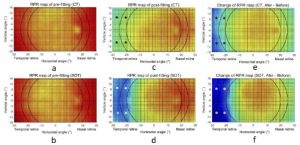Abstract
Peripheral refraction has been studied for decades; however, its detection and description are somehow simplistic and limited. Therefore, their role in visual function and refractive correction, as well as myopia control, is not completely understood. This study aims to establish a database of two-dimensional (2D) peripheral refraction profiles in adults and explore the features for different central refraction values. A group of 479 adult subjects were recruited. Using an open-view Hartmann–Shack scanning wavefront sensor, their right naked eyes were measured. The overall features of the relative peripheral refraction maps showed myopic defocus, slight myopic defocus, and hyperopic defocus in the hyperopic and emmetropic groups, in the mild myopic group, and in other myopic groups, respectively. Defocus deviations with central refraction vary in different regions. The defocus asymmetry between the upper and lower retinas within 16° increased with the increase of central myopia. By characterizing the variation of peripheral defocus with central myopia, these results provide rich information for possible individual corrections and lens design.
© 2023 Optica Publishing Group under the terms of the Optica Open Access Publishing Agreement


